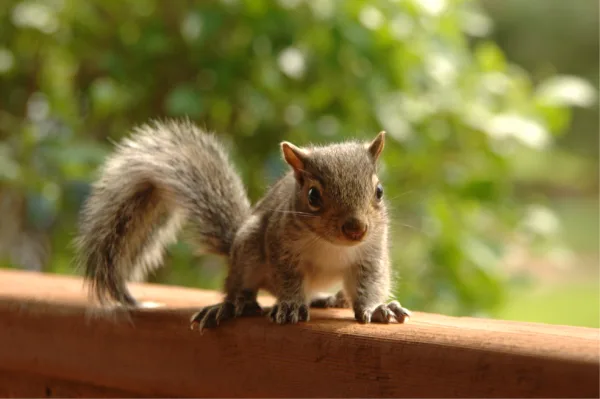Have you ever watched a squirrel scampering around your backyard, effortlessly leaping from branch to branch?
You might have wondered, How many legs does a squirrel have? It’s a question that’s both intriguing and vital to understanding these nimble creatures better.
Squirrels have four legs, just like most other mammals. These furry acrobats use their strong, flexible limbs to climb, jump, and explore their surroundings.
But there’s more to squirrels than just their legs. In this article, we’ll delve into the fascinating world of these bushy-tailed rodents and uncover some surprising facts about their anatomy and behavior.
But these four-legged wonders aren’t the only things that make squirrels so captivating. They play crucial roles in their ecosystems and have unique adaptations that help them survive in various environments.
Do squirrels have 4 legs or 2 arms and 2 legs?
Squirrels, like most mammals, have four legs. They do not have arms; their front limbs are adapted for climbing and grasping objects, which function as legs when they move on the ground. So, they have two front legs and two hind legs, making a total of four legs.
The Anatomy of Squirrels
Squirrels are a diverse group of rodents that belong to the family Sciuridae, encompassing over 200 species.
While there may be variations in size, color, and specific adaptations among different species, their overall anatomical structure remains relatively consistent.
To truly appreciate how many legs a squirrel has, it’s essential to delve into the key features of squirrel anatomy, which are fascinating examples of evolutionary adaptations in action.
Four Limbs
One of the fundamental characteristics of squirrels is their possession of four limbs, similar to the majority of mammals.
These four limbs consist of two forelimbs and two hind limbs, forming the cornerstone of a squirrel’s agile movement and remarkable versatility.
Front Legs
The front legs of a squirrel are truly specialized for their arboreal lifestyle. To grasp and navigate through the complex world of trees, these legs are equipped with sharp, curved claws.
Imagine these claws as miniature grappling hooks that allow squirrels to cling onto tree trunks and branches with ease.
This specialization in their front limbs is essential for their survival, as it enables them to access food sources, evade predators, and traverse their intricate arboreal habitats.
For example, picture a squirrel gracefully scampering along a slender tree branch, using its front legs to maintain a firm grip while searching for acorns or other delectable treats.
The adaptation of these front legs is a testament to the incredible precision of evolution.
Hind Legs
Squirrels are renowned for their remarkably powerful and adaptive hind legs, which play a pivotal role in their dynamic movements.
A perfect example of their agile use of hind legs is when a squirrel executes a spectacular leap from one tree branch to another.
With a quick burst of energy from these powerful limbs, the squirrel covers remarkable distances with ease, showcasing the adaptability of their hind legs to different environmental challenges.
Paws
Squirrel paws are yet another testament to the intricacies of their evolutionary adaptations. Each paw is equipped with five digits, including a thumb-like structure known as a hallux.
These digits are designed for precision and functionality, enabling squirrels to manipulate objects, such as nuts or seeds, with dexterity.
Related Article: What to Do If You Find a Baby Squirrel
Squirrel Adaptations for Movement
To truly appreciate squirrels and their remarkable capabilities, it is worth exploring the adaptations that enhance their movement and agility.
These adaptations not only contribute to their survivability but also make them a joy to watch in their natural habitats.
Powerful Hind Legs
Squirrels have developed powerful hind legs that allow them to jump impressive distances.
They can leap horizontally up to 20 feet and vertically up to 10 feet, thanks to their well-developed leg muscles and strong bones.
Long Tails for Balance
Squirrels possess long, bushy tails that serve multiple purposes.
Apart from aiding in communication and signaling, their tails act as a counterbalance, helping squirrels maintain stability while leaping and maneuvering through treetops.
Climbing Abilities
The limbs of squirrels are adapted for climbing. Their strong front legs and sharp claws enable them to effortlessly climb vertical surfaces like trees and even buildings.
Squirrels are known for their ability to navigate even the most intricate branches quickly and without hesitation.
Adapted Foot Structure
The foot structure of squirrels is uniquely adapted to their arboreal lifestyle. Their hind feet feature an opposable hallux that allows them to grasp branches firmly.
The front paws also have a high degree of dexterity, enabling squirrels to hold and manipulate objects effectively.
Why do squirrel legs look like this?
FAQs
How many legs does a squirrel have?
A squirrel typically has four legs.
Do all squirrels have the same number of legs?
Yes, all squirrels have four legs regardless of their species.
Are all squirrel species quadrupeds?
Yes, all known species of squirrels are quadrupeds, meaning they have four legs.
Can squirrels run on their hind legs?
While squirrels primarily move on all fours, they can also run and hop on their hind legs for short distances.
Can squirrels use their legs for climbing?
Yes, squirrels have strong legs and sharp claws that enable them to climb trees and other vertical surfaces with great agility.
How do squirrel legs help them in their daily activities?
Squirrel legs play a crucial role in their daily activities. They use their legs for walking, running, climbing, and jumping, allowing them to navigate their environment and gather food efficiently.

🐾 I’m Marquis, an animal enthusiast 🦁🐯 with a passion for both wild and home animal care. In the wild, I’ve studied majestic species like 🦍🐅, collaborating with conservationists. At home, I’m all about fostering loving environments for pets 🐶🐱🐦, with hands-on experience and shelter volunteering.




Leave a Reply